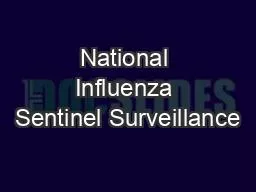

19 th 21 st October 2017 Tsirang Background Influenza Likeillness surveillance was established in 2009 as preparedness against H1N1 pandemic Burden of influenza Dominant circulating strains ID: 810102
Download The PPT/PDF document "National Influenza Sentinel Surveillance" is the property of its rightful owner. Permission is granted to download and print the materials on this web site for personal, non-commercial use only, and to display it on your personal computer provided you do not modify the materials and that you retain all copyright notices contained in the materials. By downloading content from our website, you accept the terms of this agreement.
Slide1
National Influenza Sentinel Surveillance
19
th
– 21
st
October 2017
Tsirang
Slide2Background
Influenza Like-illness surveillance was established in 2009 as preparedness against H1N1 pandemic.
Burden of influenzaDominant circulating strainsRisk groupsFirst case of pandemic strain detected in June 2009Sample sent to AFRIMS for viral detectionNational Influenza Laboratory was established in 2010 following 2009 H1N1 pandemic. (11 sentinel sites)SARI surveillance was established in 2012.
Slide3JDW/NRH
Punakha
Paro
Samtse
Phuntsholing
CRRH
Trongsa
Tsirang
ERRH
Samdrup Jongkhar
Trashigang
ILI Sentinel Sites
Slide4Background
Essentially,
There are 3 types of surveillances1. National Influenza Surveillance2. Human Influenza study (in collaboration with AFRIMS)
3. SARI surveillance
ILI
Paro
Punakha
Trongsa
Trashigang
Tsirang
S/Jongkhar
Samtse
Paro
PunakhaTrongsaTrashigangTsirangJDWNRHMongar
PhuntsholingGelephu
Slide5National ILI sentinel surveillance
Slide6Objectives of ILI
Surveillance
Describe the seasonality of influenza activity. Monitor and investigate unusual influenza activities.Monitor and detect circulating influenza viral strains and novel viruses.Contribute to WHO vaccine strain selection through GISRS. Identify and monitor high risk groups with severe
disease and mortality, in order to target education and prevention measures.
Slide7Case definitions-
ILI Case Definition
Any person with acute respiratory infection with; 1. Fever ≥ 38 ºC; AND 2. Cough or sore throat; AND 3. Onset within the last 10 days.(Note: Consider sample collection from ILI patients only if onset of fever is within the past five days)
Slide8Personnels involved in surveillance
1 Clinicians (Dr/ACO/HA)
2. Case reporters3. Laboratory Personnels
1. Identify pateints
2. Fill out demographic forms and send to lab for sample collection.
3. Record no of ILI cases
Collect and collate number of ILI patients from OPD chamber
Report all ILI cases to RCDC on weekly basis through online data system or by sms if internet facility is not available.
Ensure all forms are filled
Collect specimens and assign specimen IDs
Perform rapid test
Pack, store, and transport specimen to VML, RCDC
Maintain stock of test kits, VTM, barcodes and relevant forms in the laboratory.
Slide9Case selection and Sampling strategy
Each identified sentinel site for ILI should enroll at least 6-8 ILI cases every week (i.e. 24-32 specimen per month) for specimen collection.Equal distribution between child and adult
Slide10Updates on National Influenza Sentinel Surveillance (2017)
Sangay Zangmo
RCDC
Slide11Trend of ILI cases (2017)
Number of ILI cases
Proportion of ILI cases/1000 cases
Source: WHO flunet
Slide12Trend
Source: WHO flunet
Slide13Intensity
Source: WHO flunet
Slide14Impact
Source: WHO flunet
Slide15Geographical spread
Source: WHO flunet
Slide16Age Categorization of ILI cases
Slide17ILI visit/1000 outpatients
week 1-40, 2017
Slide18Specimen Positivity
Slide19Number of Influenza specimens positive by subtypes
Slide20Bhutan
South East Asia Region
Slide21Slide22Influenza positivity & No. of samples received
2017
Slide23Key Inference/information
from 201
surveillance
Slide24Influenza activity
2 seasonality patterns observed
Influenza activity seems to have picked up during April-May and September-October monthsIncreased number specimens as compared to 2016ILI Age group most enrolled (ILI): 15-29 years Usually mobile, captive in schools and monasteries Most turn up for medical care in the hospitals particularly during academic session.
Slide25Circulating Influenza strains
Unpredictable subtype circulation
Dominance of A/ H3 and A/ Pdm2009 strainsOne strain dominating other at the given timeCross protecting immunity to already exposed strainAntigenic drift
Slide26LIMITATIONS
Slide27Possible challenges in sentinel sites
Inconsistency in reporting & case identification
Lack of awareness among hospital staffInadequate number of sample referrals from sitesInadequate data verificationDelay in sample shipment
Slide28Challenges/Gaps in RCDC
Lack of human resources in Influenza Laboratory
Additional testing of other emerging diseases; other respiratory pathogens, dengue, malariaOther program specific activitiesNo sustained laboratory suppliesNo RGOB committed budget for the suppliesSupplies through collaboration limited (CDC & AFRIMS)No quotation from local suppliersDifficulty in Ex-country shipment of samples
Slide29Way forward
Laboratory supplies to be streamlined
Increase frequency of data verificationEstablish sustainable shipment to US CDC & WHO CCs
Slide30Thank you
All sentinel sites
US CDCAFRIMSWHOMinistry of Health